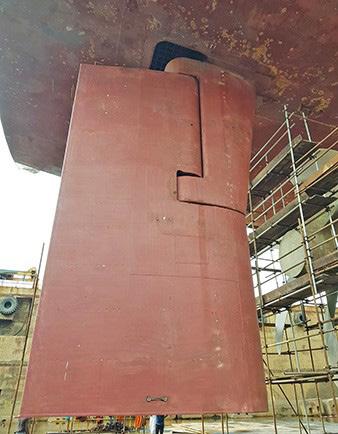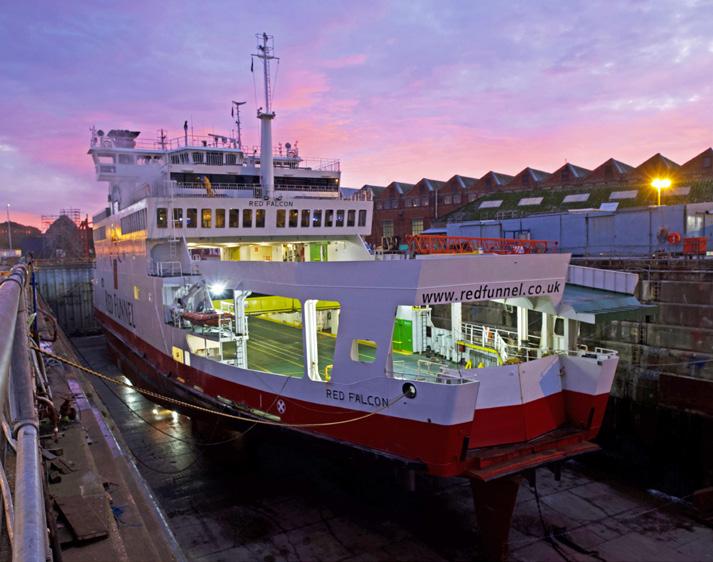
12 minute read
Bulk Carriers
By Paul Bartlett
Recent world events have caused many bulk carriers to go into lay-up
Advertisement
Dry bulk owners to benefit from war boost
Although analysts are still poring over the possible repercussions of Putin’s war on dry bulk business, they are expected to be far-reaching. Sea trade in both the second and third most important major bulk commodities – coal and grain – is likely to be seriously disrupted in what, some experts say, could become a long-running conflict. However, demand for bulk carriers is likely to rise as a result of hikes in tonne-mile demand, although analysts caution that no firm conclusions should be drawn in the early days of the war.
With a relatively modest orderbook of about 7% of the fleet, dry bulk shipping supply has limited elasticity over the next two-to-three years. Many large builders in Asia have notched up a string of new contracts lately for sectors where demand had already been running high, notably large series of containerships ordered by cash-rich carriers, and large LNG tankers for the half dozen or so yards that are capable of building them.
The implications are positive for repair yards. The outlook suggests that owners will opt to hold on to older vessels which, in a weaker market, might not have looked worthwhile. But in order to comply with IMO’s carbon intensity indicator (CII) in the years ahead, many older ships will require attention. Engine power limitation (EPL) is the first option, but experts warn that this, on its own, may not be sufficient. Other energysaving steps may be required on older vessels, as well as additional fourth or even fifth specials that would not otherwise have been necessary.
Oslo-based Cleaves Asset Management, a shipping-related hedge fund, had previously sounded positive notes on the outlook for dry bulk shipping, even before Putin invaded Ukraine. Now, it has cautiously reiterated some of the reasons for its optimism, which is broadly based on rising bulk carrier demand from longer voyages and more tonne-miles. In a recent circular, the firm noted that Russian coal is subject to sanctions, a factor which could drive longer voyages for European importers as well as Russian exporters.
According to figures from Clarkson Research, seaborne trade in coal was thought to have increased by close to 6% last year compared with 2020, although the final volumes for 2021 have not been confirmed. However, this increase reversed a significant reduction in coal movements between 2019 and 2020 – a fall of more than 9%. Figures compiled by the analysts before the war gave estimates for 2022 and 2023 suggesting modest increases of under 2% and less than 1% respectively.
The war has transformed the backdrop for global energy markets and so also in the coal trades. It is likely to have derailed COP26 decarbonisation aims at the same time. Jason Feer, Head of Business Intelligence at New York-based broker Poten & Partners, told attendees at an early-March webinar that the Russian invasion of Ukraine had ‘blown a hole’ in decarbonisation. This is because the medium- to long-term environmental benefits of cutting greenhouse gas emissions pale into insignificance beside procuring enough affordable energy today.
At the time of writing, Russian oil is still being exported and is not subject directly to sanctions, but coal exports are. However, as some have noted, sentiment is running ahead of sanctions and some European importers wish to distance themselves as much as possible from Russian commodities. In oil, gas and coal, therefore, imports to Europe have been dramatically affected.
Pipeline supplies have been hit hardest, with the German Government deciding not to grant any more approvals on the Nordstream 2 pipeline, which runs under the Baltic Sea and would have doubled Russian exports to the country pumped via Nordstream 1. Meanwhile, the 4,100 kms pipeline from the Yamal Peninsular and Western Siberia to Poland and Germany runs through pro-Russian Belarus. Both the Brotherhood and Soyuz pipelines – from Russia and Kazakhstan respectively – run across Ukraine.
However, at this stage, it is not first and foremost the issue of energy security that is focusing the minds of western energy company executives - it is the sheer scale of dramatic increases in energy prices, with more expected. For many nations that had already been struggling with the substantial increase in energy imports over 2021, the latest price rises come as a hammer blow. Long-sighted aims to cut carbon emissions are quickly assigned to the ‘future policy’ strategists while those on the front line try to figure out how to keep the lights on today and tomorrow.
And the obvious fallback is coal, of which the world has vast reserves, and which is already easily available in large quantities. More global shipments of coal would likely benefit larger bulk carriers in the capesize and panamax categories. According to the most recent edition of BP’s Statistical Review of World Energy, the world has 139 years of proven coal reserves at the current reserves-to-production ratio. Between them, Australia, China, India and the US have almost 61% of reserves, but Russia has more than 15%, second only to the US, with 23.2%. Coal prices will not stay flat – significant quantities of energy are expended in its production and transport – but they are unlikely to rise at anything like the same pace as oil and gas.
Meanwhile, disruption to the shipments of dry bulk’s third most important major commodity – grain – is likely to cause major upheaval in many long-established trades, many involving Ukraine, known as the breadbasket of Europe, and Russia. However, one outcome could be the underpinning of demand growth for bulk carriers in the handy, supramax and panamax categories. Between them, Ukraine and Russia supply about a third of the world’s grain and corn supplies.
However, there are serious implications for nations that rely on imports of wheat, for example, from Russia and Ukraine. After only a week of war, Ukrainian exports had all but ground to a halt, ports were not operating properly, and customers of Russian grain producers were seeking to distance themselves and break their long-established supply chains. The

The Russian invasion has disrupted grain trades
implications for many import-reliant countries are dire. They include some of the most vulnerable countries in the Middle East and North Africa where food production is barely possible. Food security, together with secure energy supplies, are likely to become overarching priorities in many parts of the world.
Grain in focus
Ukraine was the world’s fourth largest grain exporter in 2021, sending 49.5m tonnes of grain abroad, equivalent to more than 9% of the global total, according to estimated figures from Clarkson Research. The country’s grain is a high-quality product widely used in the milling of flour. The only other countries exporting more grain were the US, Brazil and Argentina.
Ukraine’s exports comprised about 20m tonnes of wheat and around 28m tonnes of coarse grains (corn, barley, sorghum, oats and rye) and were channelled through the ports of Odessa and Mykolaiv in the west of the country. These ports are now closed. Russia, meanwhile, exported about 36m tonnes of grain last year, according to Clarkson estimates, 7% of the world’s total. Its exports are shipped mostly from Black Sea ports using the Bosphorus and Dardanelles straits. Early in the conflict, Ukraine asked Turkey to close the waterways, placing the country in a difficult position since it is a major consumer of grain from both Ukraine and Russia.
Grain exports from the region are shipped mostly to markets in Africa, the Middle East, and Asia, with Turkey, China, Egypt and Indonesia amongst the top customers. Both countries also export grain to Europe.
Chicago wheat futures prices shot up by more than 40% in the days following the invasion and food experts warn of a rapid increase in food price inflation, already rising on the back of supply chain issues and other Covid-related factors. While rich countries may be able to soften the blow to consumers to some extent, import-reliant poor countries in Africa, for example, have very little flexibility. Food experts have warned of potential famines as a result of the war.
Dry bulk orderbook shrinks to lowest this century
Bulk carriers on order are equivalent to just 7% of the existing fleet, representing the lowest figure this century. There are about 480 bulkers on order, with a total value in excess of $16bn. To put this figure in context, the bulk carrier orderbook represented at least 20% of ships on the water over the ten years between 2005 and 2015. It hit a peak of 80% in 2008.
Today’s ships on order are almost exclusively being built in Asia. This is no new trend – most bulk carriers have been built at Asian shipyards for well over a decade. However, the focus has become even more concentrated recently. Just two countries – China and Japan between them – hold 95% of bulk carrier orders today. South Korean yards, in the picture until three or so years ago, have opted to concentrate on the design and construction of more sophisticated ship types.
Experts believe that several factors contribute to the low volume of bulkers on order today. Many Asian shipyards are full, and newbuilding prices have risen sharply over recent months. There is also the issue of investment uncertainty. A new ship ordered today might deliver in 18-24 months and, assuming a 20-year life, would operate until 2044.
Regulatory changes, advances in propulsion technology, the

A new bulk carrier design for Himalaya Shipping

A bulbous bow optimised for a ship’s actual operating profile
development of low-carbon and zero-carbon fuels, and the digital transformation that is reframing ship design and operation, all generate uncertainties which investors shy away from. The cost of ‘future-proofing’ ships ordered today to avoid the risk of stranded assets in the future is also a very real one.
However, experts suggest that new ships with optimised designs, digital connectivity, and much-improved fuel performance are definitely required. Ageing dry bulk workhorses of the sea are widely seen as one of the industry’s oldest and least efficient sectors. And it is the largest shipping sector by number of vessels and lifting capacity. As of January, this year, the world’s dry bulk fleet consisted of just over 12,000 bulk carriers of more than 10,000 dwt, with a total deadweight of almost 950m, according to figures compiled by Clarkson Research.
Over half the 10,000dwt+ fleet is more than ten years old, with these ships built before IMO’s Energy Efficiency Design Index (EEDI) was introduced in 2013. A fifth of the fleet is more than 15 years old and 11% is over 20 years. In numbers, these sectors of the dry bulk fleet consist of 2,730 ships over 15 years of which 1,423 are more than 20. Many of these vessels are likely to fall into categories ‘D’ and ‘E’ when their carbon intensity indicators (CII) are assessed following the new regulations entry into force in January 2023. The CII is measured on the basis of carbon dioxide emitted divided by deadweight and distance in nautical miles.
Ships falling into category ‘D’ for three consecutive years, and all ships rated ‘E’, will have to adopt corrective action plans as part of their Ship Energy Efficiency Management Plan (SEEMP). Experts suggest that a first move could well involve adopting an engine power limitation (EPL) strategy by which ships sail at lower speeds to reduce engine load. However, the attitude of charterers could also have a bearing on owner strategy. Ships in ‘D’ and ‘E’ are likely to be found at the back of the queue so far as many charterers are concerned. With a greater focus on supply chain sustainability, many of shipping’s customers are thought likely to focus on vessels in categories ‘A’ and ‘B’.
However, they also warn that although this could be sufficient to meet initial compliance requirements – category ‘C’ or above – CII requirements will tighten steadily over the second half of the decade, although the quantum has not yet been decided. Bulk carriers rated ‘C’ at the outset could therefore fall into ‘D’ or ‘E’ during the second half of the decade. Significant efficiency upgrades could well be required and the challenge facing many dry bulk owners is which efficiency improvements are most effective and whether the related investment will prove worthwhile.
In light of today’s buoyant market, small orderbook and lack of construction capacity, however, a significant drive to raise the efficiency of existing bulk carriers is likely, some experts predict. Rates are likely to reflect the relatively tight market conditions, helping to underpin investment decisions. Meanwhile, some owners may welcome the opportunity to wait a little longer before contracting new tonnage, perhaps gaining more insight into bulk carrier efficiency and fuel technologies of tomorrow.
Retrofit options require detailed assessment
Today’s dry bulk supply constraints indicate that a significant number of older vessels will need to be upgraded to meet IMO carbon compliance requirements. For owners looking beyond engine power limitation as a means of raising ships’ carbon efficiency, there are a number of ways to improve vessel performance. For older ships, particularly those built to designs preceding the introduction of IMO’s Energy Efficiency Design Index (EEDI), the gains are potentially substantial. But meticulous investment appraisal will be necessary to ensure that satisfactory paybacks can be guaranteed.
Vessels with high block coefficients – including bulk carriers and tankers – can usually benefit from retrofits that improve water flow around the hull, particularly at bow and stern. Analysis by classification society, DNV, suggests that the retrofit of propulsion improving devices (PID), combined with fitting an optimised propeller, can yield efficiency gains of 5% or more. The classification society said that depending on ship type, size and speed, a number of retrofit steps can be considered. These include:
• a bulbous bow optimised for a ship’s actual operating profile • an optimised propeller • PIDs such as stern ducts, wake-equalising ducts, pre-swirl ducts, preswirl stators, vortex generator fins, propeller boss cap fins, rudder bulbs in combination with propeller caps, twisted rudders • air lubrication systems • wind-assisted propulsion
DNV stressed the need for careful analysis of the likely impact of such upgrades. Although they are designed to improve hydrodynamic performance, retrofits should be undertaken only in combination with engine measures to enable a suitable light running margin after conversion. The ship’s engine still needs to operate at the minimum point of the specific fuel oil consumption curve, the classification society said.
Meanwhile, Lloyd’s Register, which has invested in two digital technology providers – Hanseaticsoft and i4 Insight – has stressed the substantial potential that digital optimisation technologies offer. Proactive dry bulk companies have already established demonstrable track records using digital systems to support decision-making by navigators.
Weather routeing is certainly not new, but the technology and degree of ship-shore connectivity has improved dramatically to the point where real-time systems are now available which can recommend possible efficiency-improving actions to bridge personnel. There are also technologies available to support just-in-time arrival, thereby minimising a ship’s fuel burn and avoiding downtime outside a destination port on arrival.
SORJ










